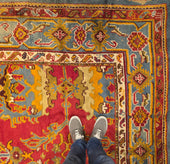Exploring the Legacy of Rug Merchants in New York
Introduction
New York City, a bustling hub of trade and culture, has a rich history intertwined with the lives of rug merchants who have contributed to its vibrant tapestry. From the late 19th century to the present day, rug merchants have played a significant role in shaping the city’s commercial landscape.
The Early Days
In the late 1800s, waves of immigrants from the Middle East, particularly from countries like Persia (modern-day Iran), Turkey, and Armenia, arrived in New York City. Among them were skilled artisans and traders who brought with them centuries-old traditions of Oriental rug weaving and trading. They established small shops in Manhattan, especially in neighborhoods like the Lower East Side and later in Midtown, where they sold intricately hand-woven rugs to the city’s growing population.
The 20th Century Boom
The early 20th century saw a boom in the demand for oriental rugs as affluent New Yorkers sought to adorn their homes with these luxurious items. Oriental Rug merchants thrived during this period, expanding their businesses and importing a wider variety of Persian and European rugs. Prominent families and business leaders often visited these shops, making the purchase of a Persian Rug or Turkish rug a symbol of status and sophistication.
Many Oriental rug merchants began to form close relationships with their customers, offering personalized services such as custom designs and home visits to ensure the perfect fit for each space. This personal touch helped build a loyal customer base and established the reputation of New York City as a premier destination for high-quality Persian rugs.
Post-War Expansion
After World War II, the Oriental and Persian rug trade in New York City continued to flourish. The post-war economic boom allowed more Americans to invest in home décor, and the popularity of oriental rugs soared. During this period, many Oriental rug merchants expanded their operations, opening larger showrooms and importing Persian and European rugs from a wider range of countries, including India, Pakistan, and Afghanistan and all over Europe.
The mid-20th century also saw the emergence of antique rug dealers who specialized in rare and collectible pieces. These merchants became experts in the history and provenance of antique Persian and European Rugs, attracting collectors and enthusiasts from around the world.
Modern-Day Rug Merchants
Today, New York City remains a vital center for the Antique and Modern rugs trade, with a mix of long-established family businesses and new, innovative merchants. The internet and e-commerce have transformed the industry, allowing Oriental rug merchants to reach a global audience. Despite these changes, the core values of quality, craftsmanship, and personalized service continue to define the rug trade in the city.
Modern rug merchants in New York City offer a diverse array of products, from traditional handmade rugs to contemporary and Modern Persian Carpets Designs. They maintain strong connections with artisans and suppliers around the world. This global network ensures that New Yorkers have access to the finest Classic and Modern Rugs available.

Conclusion
The history of rug merchants in New York City is a testament to the city’s enduring spirit of entrepreneurship and cultural exchange. From humble beginnings in immigrant neighborhoods to becoming a cornerstone of the city’s luxury market, Oriental Rug merchants have woven their legacy into the very fabric of New York City. Their stories of resilience, craftsmanship, and innovation continue to inspire and shape the vibrant marketplace of today.
Visit our store for authentic, time-honored rugs in New York.






